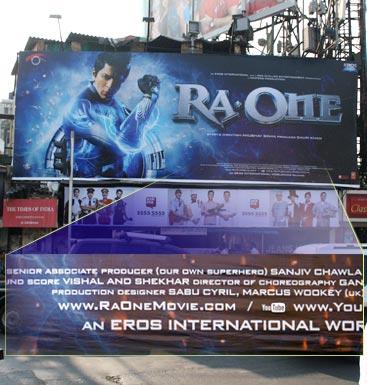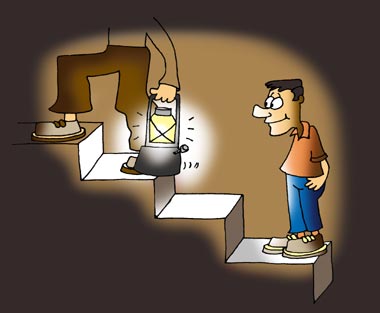Shonalee Biswas
Ra.One was an attack on the senses, unless of course you are an Arjun Rampal fan.
And it's official now that Ra.One is nowhere near a blockbuster hit that it was expected to be. It is no 3 Idiots. It is not even a Bodyguard.
As trade analyst Taran Adarsh wrote in a recent column "As for Eros/Red Chillies, well, Ra.One would ensure profits for sure, but when you attempt a film of this magnitude, you expect the profits to be in the Rs 30-crore (Rs 300 million) to Rs 40 crore (Rs 400 million) range. That might not be the case here!"
Amod Mehra, a trade analyst, told Rediff.com sometime back, "If things go well, the producers (Shah Rukh Khan and Eros Entertainment) will at the most be able to break even, but the sub-distributors are 100 per cent going to lose money. There are no two ways about it. They will lose an estimated 30 to 40 per cent of their money."
Given these details there are few interesting marketing lessons that can be learnt here.
. . .
5 marketing lessons from Ra.One
Endless promotion works only up to a certain point: The trick in the Hindi film industry has now boiled down to promoting and advertising the movie endlessly before its release and then trying to recover the money over the first three days of its release, i.e. the weekend.
The weekend effect is now thought to be a sure shot formula. Get a big star, have all the brand tie-ups in place, promote the movie big time across radio, television, newspapers and social media and release it around a festival weekend (Id, Diwali, Christmas, Holi, Easter and so on...) and hope that everyone and their grandmother come to watch the movie.
This ensures that the producer recovers his money over the weekend.
The formula does work and explains to a large extent the success of all Salman Khan movies which are inherently bad.
. . .
5 marketing lessons from Ra.One
But they work on a certain budget which makes them profitable and keep selling the story that comes with the brand Salman Khan.
So the weekend ensures that the producer recovers his money and then the music rights, ringtone rights, satellite rights, airline rights, brand tie-ups, etc ensure that he makes a handsome profit as well.
But the question is does anyone watch a Salman Khan movie on the fourth day of its release? The answer in most cases is no. But it doesn't really matter because the audience has been fooled into watching the movie through relentless promotion and the money has already been made.
Ra.One worked on the same formula. But the trouble was that its budget was so huge that even after a 5-day long weekend (from Wed, October 26, the Diwali day, to Sunday, October 30) which ensured record collections, the film will find it difficult to make money.
. . .
5 marketing lessons from Ra.One
Nothing works like the word of mouth does: Hum Aapke Hain Kaun, one of the biggest blockbusters of Hindi cinema released only in two theatres initially. But the word of mouth was so strong that the movie gradually spread to other theatres and went onto become one of the biggest hits of all time.
Of course, in this day and age when piracy can happen at the drop of a hat, no producer can take the risk of releasing his movie in two theatres. But what they can easily ensure is that the movie has some semblance of a storyline, which helps in generating a good word of mouth ensuring repeat visits by the audience.
The best example for this is 3 Idiots, which started very well, and continued to do well even after the first weekend.
But these are relatively minor points.
. . .
5 marketing lessons from Ra.One
The biggest lesson from Ra.One is that big brands cannot change their storylines.
Why Shah Rukh did not work as a superhero? Big brands have stories attached to them. And they don't make bigger brands than film superstars.
So Dilip Kumar was the brooding serious lover. Rajesh Khanna was the lover who got the girl in the end, with some hiccups thrown in between.
Amitabh Bachchan was the angry young man.
Aamir Khan is the guy who is expected to do something different in every movie that he does. Salman Khan is the bhai next door.
And Shah Rukh is the sophisticated guy next door, who gets the girl in the end, after singing a few songs in between.
. . .
5 marketing lessons from Ra.One
This story has been attached to Shah Rukh Khan since Dilwale Dulhaniya Le Jayenge (DDLJ) released in October 1995. Almost all of his biggest hits after DDLJ have had Shah Rukh playing the sophisticated guy next door, who usually gets the girl in the end.
Be it Kuch Kuch Hota Hai, Kabhi Khushi Kabhi Gham, Dil to Pagal Hai, Chalte Chalte, Main Hoon Na, Veer Zaara, etc
Whenever he is tried to go against this, be it Swades, Paheli, Kabhi Alvida Na Kahna or for that matter My Name is Khan, it hasn't worked for him.
In the recent past Chak De India was the only Shah Rukh movie that has worked where Shah Rukh did not play the guy next door.
The reason the movie worked was that it had a strong story line, which isn't a characteristic of most Shah Rukh movies, and had a fairly limited budget.
People love to watch Shah Rukh as the guy next door. That's a story that has become attached to him. And try he may he cannot get rid of it.
. . .
5 marketing lessons from Ra.One
Marketing guru Seth Godin explains this very well in his book, All Marketers Are Liars. He writes, "Great stories happen fast. They engage the consumer the moment the story . . .
5 marketing lessons from Ra.One
Big brands come with stories attached to them: Let's take the case of Amul, a brand that has come to be associated with 'milk'. Whenever the brand has tried to do something else with the Amul name be it selling pizzas or for that matter a chocolate drink called 'Nutramul', it hasn't worked.
Similarly, attempts by Wills, a cigarette brand, to sell clothes under the same name have come a-cropper.
Kingfisher's attempts at running a low-cost airline were not well received.
Fair and Lovely has always been a fairness cream, something that is sold on the proposition of 'kaale ko gora bana de'. When the company tried to change this a few years back, it did not work and the company had to come back to this story.
. . .
5 marketing lessons from Ra.One
Learning from Coca-Cola: One of the greatest examples in this case is Coca-Cola. Donald R Keough, a former president of the Coca-Cola Company, recounts this in his book, The Ten Commandments for Business Failure.
Research carried out by consultants figured out that consumers are looking for something sweeter than Coca-Cola was. This led Coke to launch New Coke.
Consumers did not like this tinkering with taste of Coca-Cola. And some of them started hoarding bottles of old Coca-Cola. One day when Keough was at the company's call centre when an old woman called.
As he writes, "It was an 85-year-old woman who convinced me we had to do something more to stay the course. She had called the company in tears from a retirement home in Covina, California. I happened to be visiting the call centre and took the call. "You've taken away my Coke," she sobbed. "When was the last time you had Coke?" I asked. "Oh, I don't know. About twenty, twenty-five years ago." "Then why are you so upset?" I asked. "Young man, you are playing around with my youth and you should stop it right now. Don't you have any idea what Coke means to me?""
. . .
5 marketing lessons from Ra.One
After this the top brass of Coca-Cola decided to relaunch the old Coca-Cola as "Coca-Cola Classic". And there is a lesson to be learnt from this for Shah Rukh Khan.
He needs to stick to his classic old story of the sophisticated guy next door, who gets the girl in the end and sings a few songs in between. This is something that Salman Khan does very well. His movies are also an assault on the senses, but he sticks to his story of projecting a bhai image in all his movies and it works for him.
The trouble of course is that age is catching up with Shah Rukh, and he can't keep playing the boy next door.
Shah Rukh that way is at the same place Amitabh Bachchan was in 90s when his attempts to play the angry young man in movies like Lal Badshah and Mrityudata did not work at all. Bachchan did rediscover himself and went onto do some brilliant roles that suited his age. Maybe it's time that Shah Rukh realised that as well.
The author can be reached at shonalee.biswas@rediffmail.com











article